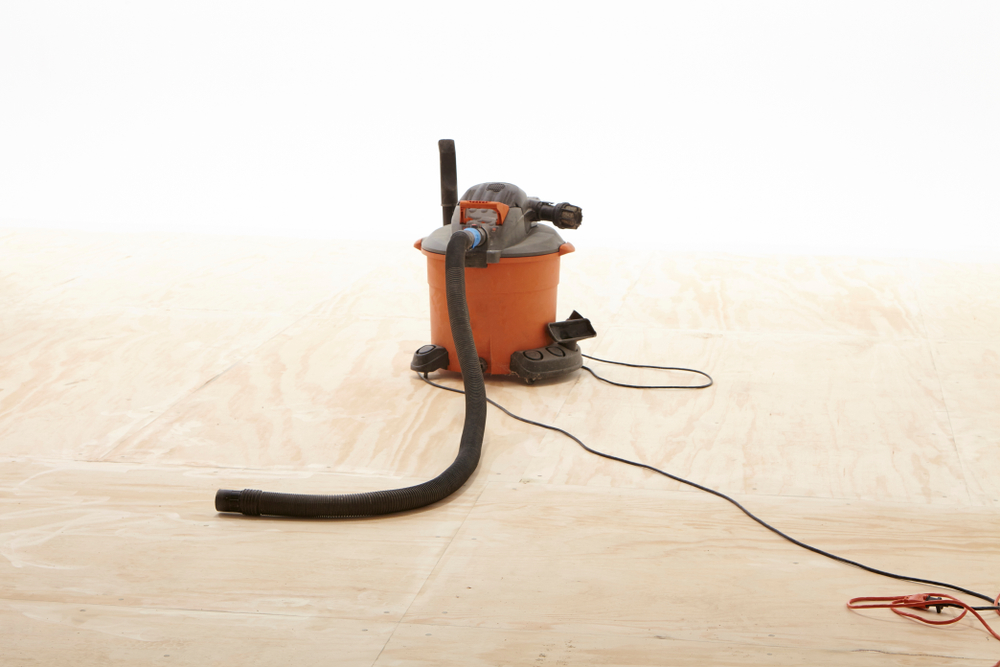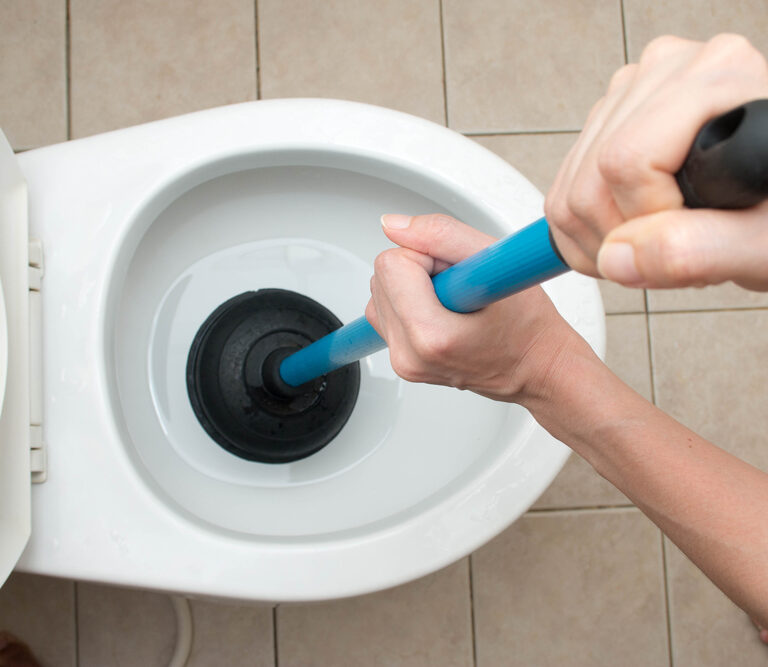Toilets can usually take a lot of crap, but when they get clogged, things can get messy. If you find yourself with a clogged toilet, don’t worry. You can avoid an overflowing toilet and an expensive bill from the plumber by taking matters into your own hands (just remember to wear gloves).
Using Basic Plumbing Tools
When it comes to dealing with clogs, having the right tools for the job makes your life a lot easier. There are a couple of common tools that are easy to use and work effectively to clear all but the worst clogs. And you may even have one of them in your bathroom already.
Toilet Plunger
Plungers are a common household tool. If you’ve ever used one, you know they’re great at freeing nasty clogs in your toilet. However, there are a few different types of plungers, and you’ll want to make sure you’re using the right type.
- Cup plunger – This is the most common type of plunger, and the type that probably comes to mind when you think of a plunger. But these rubber domes are made for flat surfaces, such as sink and shower drains, and aren’t very effective for toilets. Avoid using this type of plunger, if possible.
- Flange plunger – A flange plunger usually works well for toilets. With a flange at the end, it allows the plunger to effectively form a seal to create pressure as you push or pull the plunger. It isn’t as effective as an accordion plunger, but it’s easier to use, and works better than a cup plunger.
- Accordion plunger – This is another type of plunger that works well on toilets. Accordion plungers are typically made of hard plastic and are a little harder to use than flange plungers. However, they can also produce greater pressure for pushing through tough clogs, making them a great choice for particularly bad clogs.
How to Use a Plunger
- When using a plunger, make sure the flange is in the drain hole, and that there’s water in the toilet bowl.
- Orient the plunger as vertically as possible to create and maintain an effective seal.
- Use gentle, yet firm up and down thrusts to help break the clog free – plunge too hard, and you could break the wax seal between the floor and your toilet.
- The plunger will initially force out the air from the inside of the plunger, so take it easy on the first push, and be wary of splashing.
- As you pull up, the plunger will suck up water from the toilet, allowing you to use the water to create a pressurized jet of water to push the clog out of the trap and into the drainpipe.
Tips for Creating a Better Seal
If you’re having trouble getting the plunger to form a proper seal, there are a couple of things you can try.
- Warm your plunger up with hot water to soften it up. This allows it to form to the shape of the drain hole better and create a seal.
- Rub a ring of petroleum jelly around the flange of the plunger. This will help eliminate any small air gaps between the toilet and plunger that prevent it from sealing.
Plunger Alternatives
If you’re in a pinch and you don’t have a plunger handy, you can try putting a toilet brush or mop in a plastic bag to use as a plunger. The plastic bag will help it create a better fit and form a seal with the drain hole.
Of course, this won’t be as effective as a plunger, but it can create some positive pressure that may free a minor clog in the trap.
Toilet Auger
A toilet auger (also known as a closet auger) may work where a plunger won’t, by physically reaching down into the toilet to push or bust through the clog. This works great if your toilet is clogged with something like a cardboard toilet paper roll, and you can’t free it with a plunger.
Like a drain snake, an auger may also pull things back up with it, thanks to the coiled tip. However, unlike a drain snake, it’s specifically meant for toilets. This is because of the plastic housing, which guides the snake up into the trap of the toilet to avoid scratching the porcelain where it’s visible.To use a toilet auger, you’ll want to start by putting the auger in the toilet so that the hook goes into the drain. Slowly feed the auger through the toilet’s trap while turning the handle. This will help it around the bends in the trap.
Once you’ve hit the clog, apply pressure as you turn the handle to break up the clog or push it through.
Auger Alternatives
If you don’t have a toilet auger lying around, we recommend you get one for future use. However, if you’re in a pinch, you could try using a metal coat hanger to bust through the clog. Simply straighten the coat hanger out and carefully feed it through the trap. Carefully twist and turn the hanger until you’ve hit the clog.
If you’re worried about scratching the porcelain, you may want to cover the end of the coat hanger with a rag. Make sure to tightly secure the rag to the hanger with something like duct tape or a zip tie, so you don’t worsen the clog.
Using Other Things From Around the House
If you don’t have a proper plunger or auger handy, and using a makeshift alternative is out of the question, there are still a couple of other things you can try.
Liquid Soap and Hot Water
If you’ve got a minor clog, you can try using liquid soap and hot water to help push the clog through. The soap will act as a lubricant, while the hot water will work to help bust through the clog.
Start by adding some liquid soap to your toilet. Many people use dish detergent, but you may also use shampoo, hand soap, or laundry detergent. Since liquid soap is denser than water, you’ll want to let it sit for 30 minutes, so it can sink down into the drain, where it can lubricate the clog.
After 30 minutes, pour a bucket of hot water into the toilet, and let it sit for a few minutes. If you’re successful, the clog will free itself, thanks to the combination of lubrication and heat.
Don’t Use Boiling Water
Make sure the water is hot, but not boiling. Using boiling water can cause a rapid temperature shift that can cause the porcelain to crack. The excess heat can also melt the wax ring that sits between the toilet and drainpipe. If that happens, you’re looking at an even bigger job than a simple clog.
Baking Soda and Vinegar
Two of the favorite ingredients of life hackers and mommy bloggers everywhere, baking soda and vinegar can help bust through a clogged toilet.
Start by removing as much water from your toilet as possible. Pour 1-2 cups of baking soda into your toilet, and slowly chase it with 1-2 cups of vinegar. The resulting mixture will create a fizzy chemical reaction that can help loosen the clog.
After 30 minutes, pour a bucket of hot water into the toilet. As with the soap method, you’ll want to let it sit for a few minutes if it doesn’t immediately clear the clog.
Breaking Out the Big Guns
If you’ve tried other plumbing tools and life hacks, only to find that nothing is working, then you might have to break out the big guns. These are a couple of last resort methods that would be appropriate for seriously sinister clogs.
Wet-Dry Vacuum

If you’ve got a nasty clog that other tools and tricks won’t fix, you might have to resort to using a wet-dry vacuum, or shop vac. Unlike typical household vacuums, which aren’t engineered to handle liquids, shop vacs can handle solids and liquids, and are an invaluable tool for taking care of clogs.
When using a shop vac to clear a clog, you’ll want to start by using it to suck up the water out of the toilet. Place it in the drain like a plunger and wrap a towel or rag around the hose to create a seal.
Use one hand to hold the rag in place to help create and maintain the seal, and turn the vacuum on. Once you think you’ve pulled up the clog, turn the vacuum off and see if the toilet drains.
Removing the Toilet
If you’ve got a particularly pernicious clog, and you’re determined to clear it yourself, you may have to resort to removing the toilet. This shouldn’t be necessary for ordinary clogs. Rather, this is for more extreme clogs, like when the kids flush toys or other foreign objects down the toilet.
Positively, this method will help prevent you from losing the object further in your pipes, where it may be more difficult for you to remove yourself.
When removing the toilet, you’ll want to take great care in handling it. Toilets are big, heavy, and fragile. One wrong move, and you can damage the toilet, so you’ll want to be sure you know what you’re doing.
You’ll also want to keep in mind that you’ll need a new wax ring if you plan to remove your toilet, as wax rings aren’t reusable. However, there are reusable alternatives available — should you ever need to deal with a similar clog in the future.
Since the process is a bit more involved than using a plunger or auger, your best bet is to follow a guided tutorial. A video tutorial like this one should help you with the process of removing and replacing your toilet.
Avoid Using Chemical Drain Cleaners
If you’re thinking about using chemical drain cleaners, you might want to think twice. The drawbacks often outweigh the benefits, and drain cleaning chemicals don’t always work anyway. But you aren’t just pouring money down the drain – you may ruin your toilet.
Most Drain Cleaners Are Not for Toilets
Many drain cleaners, like Drano and Liquid Plumr, contain harsh chemicals like sodium hypochlorite (bleach) and sodium hydroxide or potassium hydroxide (lye). Many manufacturers warn you not to use their products in toilets, and for good reason.
This is because drain cleaners typically work by using chemicals that react with water to create an immense amount of heat to break up clogs. However, the heat generated by these chemicals may cause the porcelain to crack. It may also melt the wax ring that keeps the water in your toilet from leaking out at the base.
Once the wax ring’s seal breaks, you’ll have to take the toilet off and replace the wax ring. And if the toilet cracks, you’ll need to add a new toilet to your shopping list as well. Plus, you’ll likely be left with a nasty mess to clean up to boot.
Of course, there are exceptions to the no chemical drain cleaners rule.
Enzyme-Based Drain Cleaners
Enzyme-based drain cleaners, like Green Gobbler, are a safe option for use in toilets, and are free of harmful chemicals like bleach and lye. However, since these cleaners use microorganisms to eat away at organic material in your pipes, they can take some time to work – at least 24 hours. They also work better as a preventative measure than as a clog buster.
If you’re looking to keep your drains running well, then consider using an enzyme-based cleaner as part of routine maintenance.
Don’t Flush Your Money
Clearing a clogged toilet may be a hassle, but it beats having to flush your money trying to beat it. With plenty of affordable and easy ways to do it yourself, you can keep things flowing and conquer any clog that makes its way into your toilet.
